Dance Appreciation
Topic outline
-
Welcome to Dance Appreciation!
Course Introduction
Dance Appreciation is an introduction to dance as an art form. Throughout the semester, we'll study the historical, cultural, social, and performative contexts of various dance genres. By engaging in aesthetic, theoretical, and scholarly discourses, we can reflect on how dance functions as a form of personal expression and communication and how dance reflects on contemporary society.Upon successful completion of this course, the student will be able to:
1. Recognize the elements of dance and apply that knowledge to analyze, explore and experience dance.
2. Understand the history of western performance dance and summarize major events in its development.
3. Apply knowledge gained in the course to develop a culturally informed dance aesthetic and a personal definition of dance.
Adopting institution should provide learners information on how to navigate the course. Consider adding an introductory navigation video. Text description could include, for example:Navigating the Course
This course is set up in Modules covering various topics which may be accessed from the course navigation menu on the left or by scrolling below. Modules may be collapsed in the menu and it the body of the course to minimize scrolling. Each module includes the relevant chapters followed by various activities, which may include discussion forums, listening activities and quizzes, practice quizzes, module tests, and other relevant activities as appropriate for each module. Many items are required and may be marked as completed automatically when the activity has been submitted (the broken check box), but others will marked as done by the student (the solid check box).Please move through the items below and continue through the Learner Support and Getting Started modules before moving on to Module 1. Be sure to check for announcements and due dates to stay on track.
 This course and its contents are licensed under a Creative Commons Attribution 4.0 International License by LOUIS: The Louisiana Library Network, except where otherwise noted.
This course and its contents are licensed under a Creative Commons Attribution 4.0 International License by LOUIS: The Louisiana Library Network, except where otherwise noted. -
CDNC 1013 Dance Appreciation
COURSE NUMBER and Name Syllabus is licensed Creative Commons Attribution 4.0 International License by Vanessa Kanamoto, Susan Perlis, Roshanda D. Spears, Mary Francis "Cissy" Whipp.
Course Number and Title: CDNC 1013 Dance Appreciation
Course Brief Description: Introduction to various forms of dance (to include ballet, tap, jazz, modern, and social dance) with an emphasis on dance technique, history, theory and appreciation. (3 Credits)
Prerequisite Knowledge: None
Course Goals:
At the end of this course, students will be able to:
· Recognize the elements of dance and apply that knowledge to analyze, explore and experience dance.
· Identify and explain the history of western performance dance and summarize major events in its development.
· Apply knowledge gained in the course to develop a culturally informed dance aesthetic and a personal definition of dance.
Course Materials:
List required and recommended course materials.
“So You Think You Know Dance” by V. Kanamoto, S. Perlis, R. D. Spears, and C. Whipp
Textbook is linked in each module.
Instructor Contact Information: [THIS SECTION MAY BE MODIFIED BY TEACHING FACULTY]
Instructor:
· Name: [THIS SECTION MAY BE MODIFIED BY TEACHING FACULTY]
· Email:[THIS SECTION MAY BE MODIFIED BY TEACHING FACULTY]
· Phone: [THIS SECTION MAY BE MODIFIED BY TEACHING FACULTY]
· Office: [THIS SECTION MAY BE MODIFIED BY TEACHING FAULTY]
· Office Hours: [THIS SECTION MAY BE MODIFIED BY TEACHING FACULTY]
MWF 9:00AM-11:AM and 2:00PM-4:30PM
· Communication policy [THIS SECTION MAY BE MODIFIED BY TEACHING FACULTY] Timely communication is an e-learning best practice. Check your email and the News and Announcements Forum on the course front page daily to make sure you do not miss any communications from your instructor or classmates. Contact the instructor in advance if you are going to miss an assignment or turn in work late. This will give the instructor sufficient time to allow for discussing an alternative schedule.
Course Schedule: [THIS SECTION MAY BE MODIFIED BY TEACHING FACULTY]
Module
Topics and Concepts
Corresponding Course Materials
1
What is Dance? Purposes of Dance/Intro to Elements of Dance
Chapter 1
Chapter 2
2
Ballet
Chapter 3
3
Modern Dance
Chapter 4
4
Tap and Jazz
Chapter 5
5
Musical Theater, Film and Television
Chapter 5
6
Religious and Social Dance
Chapter 6
7
Hip Hop and Current Trends
Chapter 7, 8, 9
Course Policies:
Technology Requirements: [THIS SECTION MAY BE MODIFIED BY TEACHING FACULTY]
Desktop or laptop computer - suggested minimums:
- 250 GB hard drive or higher.
- 4 GB RAM or higher.
- 2.4 GHz processor or faster.
- Windows 10 or current MAC OS X.
- 1024 x 768 resolution monitor or better
- Anti-virus program (updated regularly)
- Microsoft Office (latest version) or alternative if it is compatible with Microsoft Office
- Acrobat Reader
Web Browser (always update regularly): [THIS SECTION MAY BE MODIFIED BY TEACHING FACULTY]
- Google Chrome
- Safari
- Microsoft Edge
- Mozilla Firefox
Other devices and equipment: [THIS SECTION MAY BE MODIFIED BY TEACHING FACULTY]
- A webcam
- Working microphone and speakers
- A headset or earbuds with microphone may be a better option
- Smartphone or other video recording device
- YouTube account (set to private)
Computer Skills: [THIS SECTION MAY BE MODIFIED BY TEACHING FACULTY]
Skills with Learning Management System (LMS) , proficiency with software packages (Microsoft Office), library databases, Zoom, etc.
Evaluation: [THIS SECTION MAY BE MODIFIED BY TEACHING FACULTY]
Your grade in this course will be determined by the specific activities and assessments described in this syllabus. Make sure you read all of the instructions! Please note that all due dates and times are in Central Standard Time (CST). Complete all your assignments! No assignment is too hard for you to produce material.
Each module requires a minimum of approximately twelve to thirteen hours of in-class work (viewing and completing activities in Moodle) and approximately six to seven hours of out-of-class work (readings, research, study time). This means you will complete approximately nineteen hours of total work per week.
Federal Financial Aid regulations require the confirmation of course participation in order for students to receive financial aid. In this course, this is achieved by documenting student completion of an academic activity by the last day to add courses for credit or change sections, which is usually the fifth day of class. This activity is designated "AEA" in Module 1. Failure to complete this activity within this time period may result in a delay in the disbursement of financial aid funds.
There is also a required academic activity due on the last day of class to ensure student engagement throughout the full term.
Grading Policy: [THIS SECTION MAY BE MODIFIED BY TEACHING FACULTY]
Grade Breakdown and Grading Scale
The following grading scale applies:
97%−100% = A+
93%–96% = A
90%–92% = A-
87%–89% = B+
83%–86% = B
80%–82% = B-
77%–79% = C+
73%–76% = C
70%–72% = C-
67%–69% = D+
63%–66% = D
60%–62% = D-
0%–59% = FUniversity Policies and Support: [THIS SECTION MAY BE MODIFIED BY TEACHING FACULTY]
· Code of Conduct: [THIS SECTION MAY BE MODIFIED BY TEACHING FACULTY] Online courses must comply with the Code of Student Conduct. Academic misconduct includes but is not limited to cheating, plagiarism, collusion, falsifying academic records, and/or any act designed to give unfair academic advantage to the student. Preventing academic misconduct requires learners to take ownership of their individual work for individual assignments and assessments. Learners who violate the Code of Student Conduct will be referred to Student Advocacy & Accountability. For undergraduate students, a first academic violation could result in a zero grade on the assignment or failing the class and disciplinary probation until graduation. For a second academic violation, the result could be suspension. For graduate students, suspension is the appropriate outcome for the first offense.
To read more, please visit the [LINK TO STUDENT CONDUCT WEBPAGE].
· Online Etiquette: [THIS SECTION MAY BE MODIFIED BY TEACHING FACULTY] Communication in the online classroom comes across differently than the communication we are accustomed to through academic writing and face-to-face classroom discussion. Use online etiquette guidelines like the ones listed in the document below to craft your communication.
Read “The Core Rules of Netiquette” by Virginia Shea (1994) to understand the human aspect of online communication. [LINK TO DOCUMENT]
· Academic Integrity: [THIS SECTION MAY BE MODIFIED BY TEACHING FACULTY] It is your responsibility to refrain from plagiarizing the academic property of another and to utilize appropriate citation method for all coursework. In this class, it is recommended that you use MLA or APA style. Ignorance of the citation method is not an excuse for academic misconduct. Remember, there is a difference between paraphrasing and quoting and how to properly cite each respectively.
One tool available to assist you in correct citations is the “References” function in Microsoft Word. This program automatically formats the information you input according to the citation method you select for the document. This program also has the ability to generate a reference or works cited page for your document. The version of Microsoft Word with the “References” function is available in most University computer labs.
All work must be completed without assistance unless explicit permission for group or partner work is given by the faculty member. This is critical so that the professor can assess your performance on each assignment. Read the syllabus and assignment directions carefully. When in doubt, e-mail your instructors or ask in a discussion forum. Seeking clarification is your responsibility as a student. Assuming group or partner work is okay without permission constitutes a violation of the Code of Student Conduct.
· Diversity Statement: [THIS SECTION MAY BE MODIFIED BY TEACHING FACULTY] Diversity is fundamental to the institutional mission and the university is committed to creating and maintaining a living and learning environment that embraces individual difference. Cultural inclusion is of highest priority. The university recognizes that achieving national prominence depends on the human spirit, participation, and dedicated work of the entire university community. Through its Commitment to Community, this institution strives to create an inclusive, respectful, intellectually challenging climate that embraces individual difference in race, ethnicity, national origin, gender, sexual orientation, gender identity/expression, age, spirituality, socioeconomic status, disability, family status, experiences, opinions, and ideas. The university proactively cultivates and sustains a campus environment that values open dialogue, cooperation, shared responsibility, mutual respect, and cultural competence—the driving forces that enrich and enhance cutting-edge research, first-rate teaching, and engaging community outreach activities.
· Accessibility and Disability Services: [THIS SECTION MAY BE MODIFIED BY TEACHING FACULTY] A learner with a disability is entitled by law to equal access to university programs. Two federal laws protect persons with disabilities in post-secondary education: the Rehabilitation Act of 1973 (Pub. L. No. 93-112, as amended), the 1990 Americans with Disabilities Act (Pub. L. No. 101-336) and the ADA Amendments Act (Pub. L. No.110-325). This insitituion is committed to ensuring that its websites, online courses, and all online materials are accessible to people with disabilities.
If you have accessibility needs that we can help with, visit the Office of Disability Services and register for accommodations before you begin your course work. If you have questions about accessibility for specific tools and external materials used in this course, please see the "Course Materials " and "Technology Requirements" sections in this syllabus.
· Technology Support: [THIS SECTION MAY BE MODIFIED BY TEACHING FACULTY] If you have questions about the functionality of your course, review the IT Technical Requirements to make sure you have the right equipment and software.
If you have any technical problems or questions, email the IT Help Desk at [IT e-mail address] or call [IT Phone Number (xxx) xxx-xxxx]. Be sure to mention your name, course number, and section.
· Academic Support Services: [THIS SECTION MAY BE MODIFIED BY TEACHING FACULTY] We are dedicated to ensuring that you have the tools and resources you need to be successful in your studies at this institution. Our programs are designed to assist you in refining and strengthening the academic skills necessary for success at the university—and beyond. We do our best to ensure that each student receives personal attention and assistance with his/her problems and concerns. All you have to do is take the initiative to seek assistance, and we will be here to help. [LINK TO e-mail address and Phone numbers for campus services]
-
This module contains all the items you should review and complete before you begin Module 1. Before moving on, be sure to:
- Check the News and Announcements Forum
- Read the Course Syllabus
- Introduce yourself to the class
- Read the instructions for the Q & A Forum
Good luck in the course!-
Use this forum to tell us a little about yourself and your interests. Some topic ideas:
- What are you most interested in learning about in this class and why?
- Have you ever taken an online class before?
- Any other information you would like to share with your classmates, such as special interests or activities.
- What are your 3 goals/what do you hope to learn in this class?
We look forward to meeting you.
-
Use this forum to ask your instructor any questions you have about the course. You may post at any time, and your instructor will respond here. Be as specific as possible.
Please keep in mind that others can see your posts, so do not post any personal information. If you have questions about your grade, please email your instructor directly. You can expect a response to posts and emails within 24 hours.
- Check the News and Announcements Forum
-
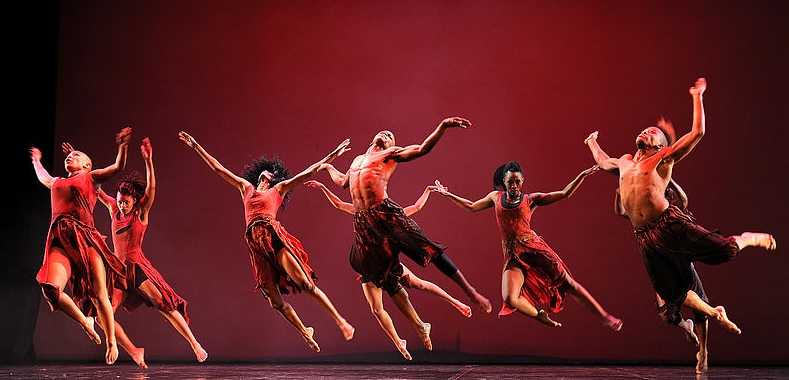
Image Attribution: CC-SA-3.0 Jazz Art Dance Theater July 6 2012.
Why do we dance? What influences the way we experience and respond to dance? What are the elements we use to make each dance unique and expressive? In this module, you will acquire knowledge of what makes dance. You will look at dance analytically in terms of the elements of dance. You will use these analytical skills throughout this course as you appreciate dance around the world and through the ages.
Upon completion of this module, you will be able to:- Demonstrating a culturally informed dance aesthetic.
- Identifying the purposes of dance.
- Recall the Elements of Dance
- Distinguish between the Elements of Dance
- Analyze, identify, and describe the Elements of Dance
To achieve these objectives:
- Read the Module 1 Introduction.
- Read and view the materials in the Module 1 So You Think You Know Dance Ch. 1 and Ch 2.
- Complete the assignments.
Note the check boxes to the right that help you track your progress: some are automatic, and some are manual.
Module Pressbooks Resources and Activities
You will find the following resources and activities in this module at the Pressbooks website. Click on the links below to access or complete each item.
-
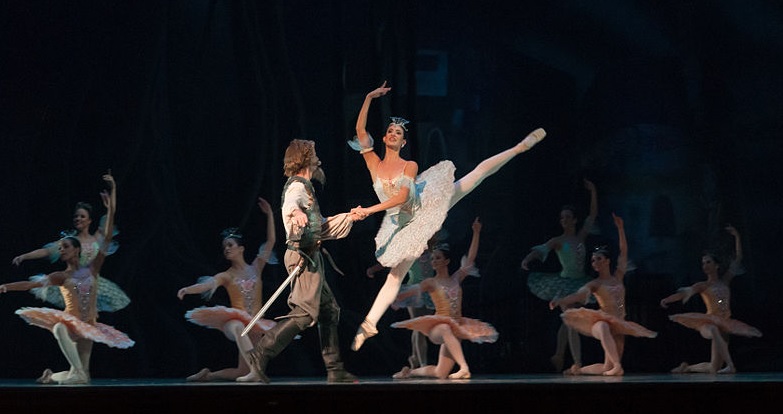
Image Attribution: CC0-Universal Public Domain Wilfredor August 20 2013
Ballet is the epitome of classical dance in Western cultures. Classical dance forms are structured, and stylized techniques developed and evolved throughout centuries requiring rigorous formal training. Ballet originated with the nobility in the Renaissance courts of Europe. The dance form was closely associated with appropriate behavior and etiquette. Eventually, ballet became a professional vocation as it became a popular form of entertainment for the new middle-class to enjoy. Ballet spread throughout the world as dance masters refined their craft and handed their methods down from generation to generation. Over 500 years, it has developed and changed. Dancers and choreographers worldwide have contributed new vocabulary and styles, yet ballet’s essence remains the same.
Upon completion of this module, you will be able to:- Explain the function of court dance and the development of ballet.
- Summarize the development of ballet from its professionalization through Romantic, Classical, Avant-Garde, Neoclassical, and Contemporary Ballet.
- Associate major ballet milestones with the works and choreographers responsible.
To achieve these objectives:
- Read the Module 2 Introduction
- Read and view the materials in the Module 2 So You Think You Know Dance Ch. 3
- Complete the assignments.
Module Pressbooks Resources and Activities
You will find the following resources and activities in this module at the Pressbooks website. Click on the links below to access or complete each item.
-
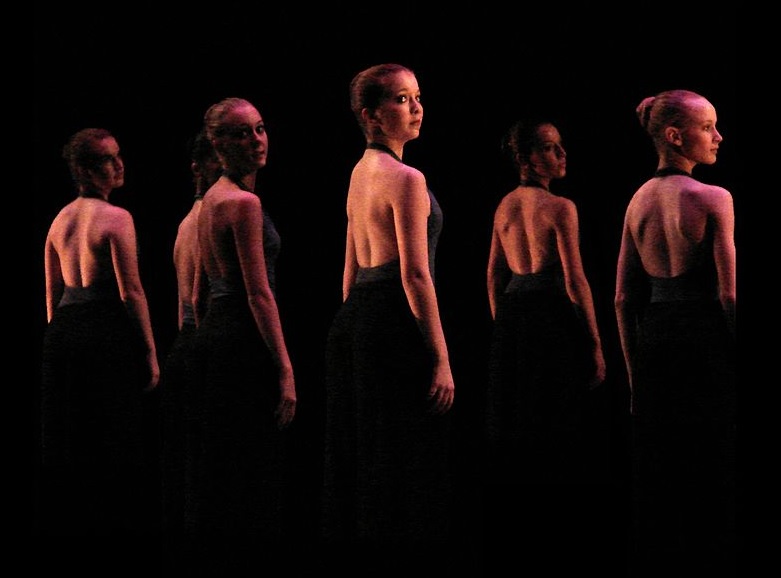
Image Attribution: CC-SA-3.0 David R Tribble May 17 2009
In the early twentieth century, choreographers broke away from the strict traditions of ballet to develop dance as varied and rich as the American melting pot. Choreographers drew upon the styles of many cultures to create a new dance form as diverse as the citizens and expressive of the independence of the American spirit. Black dancers and choreographers explored their African and Caribbean roots and shaped their own form of expressive modern dance. Others sought new movement to depict the human condition. Inevitably, dances were shared, merged, and reimagined. No matter the case, early pioneers of modern dance explored new ways to express themselves in more natural and free form while conveying the spirit of their times.
Upon completion of this module, you will be able to:- Explain the similarities and differences between ballet and modern dance.
- Identify key techniques and prominent figures in modern dance history
- Understand the history of western performance dance and summarize major events in the course of its development
To achieve these objectives:
- Read the Module 3 Introduction
- Read and view the materials in the So You Think You Know Dance Ch. 4
- Complete the assignments.
Module Pressbooks Resources and Activities
You will find the following resources and activities in this module at the Pressbooks website. Click on the links below to access or complete each item.
-
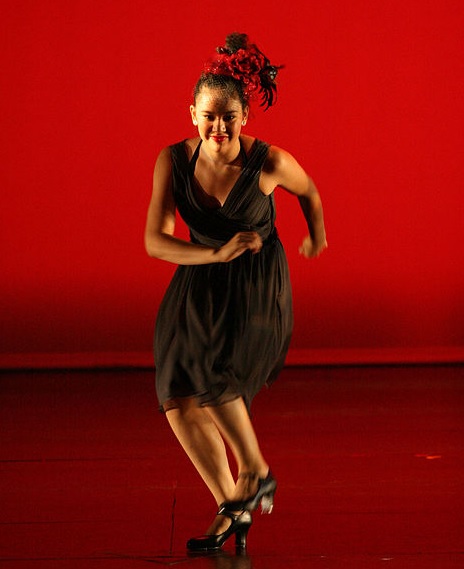
Image Attribution CC-SA-4.0 Jim Lamberson Feburary 7 2015
The development of jazz and tap dance forms resulted from West African dance forms that were eventually blended with other cultures, beginning with the transatlantic slave trade in the mid-late 16th century. While slaves were transported to what we now know as the United States, the ship’s captains wanted to keep their cargo healthy. The enslaved people were brought on top of the ship to actively perform what was called “dancing the slaves.” They stayed shackled; however, they came up with creative ways to exercise and mimicked the percussive sounds derived from drums that were an integral part of their culture. The Africans used their bodies to maintain some of these sounds and rhythms, such as hambone. From African, Spanish, Irish, and other cultural dance roots, tap and jazz dance forms were unstructured, and over time, became structured forms of dance that have blended and evolved over the years. The American inventions of tap and jazz were built from African drumming rhythms mixed with other forms of dance cultures and rhythms. It is important to note that Jazz Dance, Tap Dance and jazz music are the only forms of dance and music created in the United States by our enslaved African ancestors. As the country changed, adding immigrants from Europe, the Middle East, the Caribbean, South America and Africa, social dances absorbed all these flavors and produced exciting new forms. Minstrel shows of the early 1800s were replaced by Vaudeville shows after the Civil War. Post World War I, ragtime music was disappearing into jazz.
Upon completion of this module, you will be able to:- Identify key techniques and prominent figures in tap and jazz dance genres.
- Understand the history of tap and jazz dance and summarize major events in the course of its development.
- Demonstrate a culturally informed dance aesthetic.
To achieve these objectives:
- Read the Module 4 Introduction
- Read and view the materials in Ch. 5 So You Think You Know Dance
- Complete the assignments.
Module Pressbooks Resources and Activities
You will find the following resources and activities in this module at the Pressbooks website. Click on the links below to access or complete each item.
-
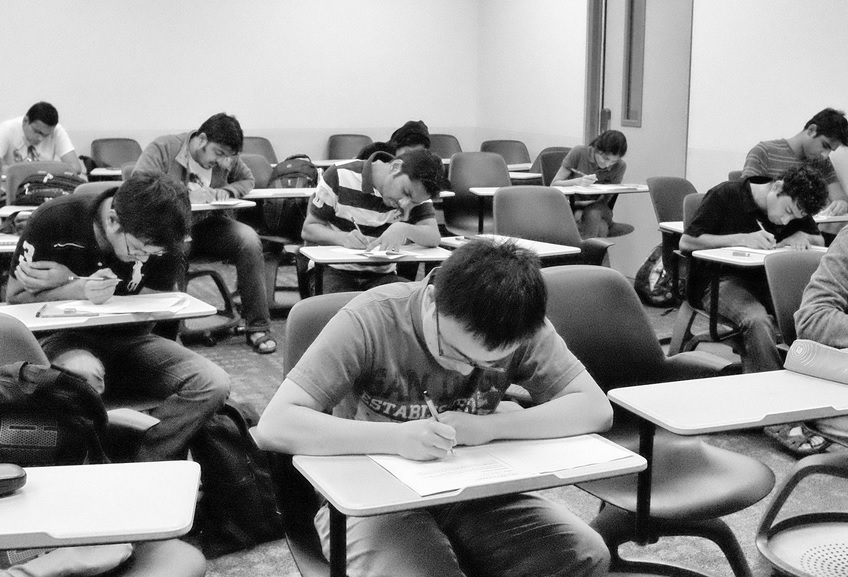
Image Attribution CC-BY-NC-SA 2.0 Pedro Szekely May 11 2003 In this module you will take your midterm exam. Read the instructions carefully and take note of any special submission guidelines.
Upon completion of this module, you will have:- Read and viewed the midterm exam (to be added) instructions.
- Scheduled your exam with the proctoring service.
- Prepared for and submitted your midterm assessment .
To achieve these objectives:
- Read and view the contents of "Exam Information and Instructions"
- Log in to the proctoring service and take your exam.
-
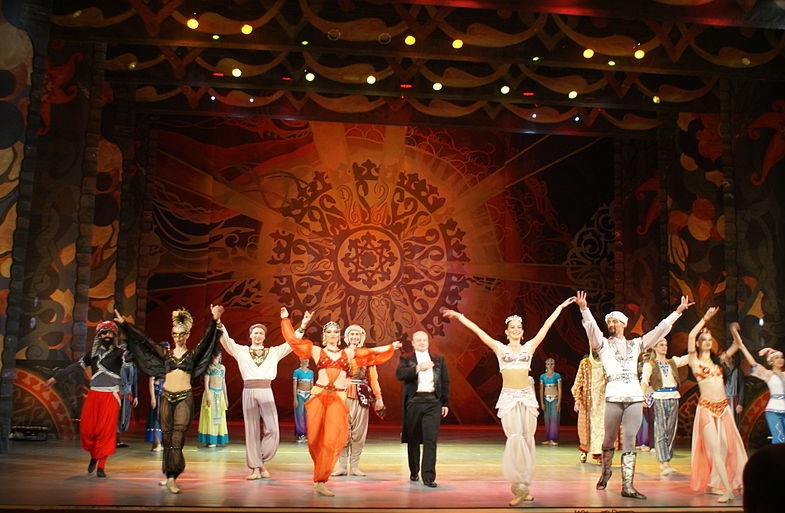
Image Attribution CC-SA 3.0 Хомелка June 5 2014
The history of musical theater, film, and television developed out of Tap and Jazz traditions.
Upon completion of this module, you will be able to:- Identify key techniques and prominent figures in musical theater, film, and television.
- Understand the history of musical theater, film, and television and summarize the major events in the course of its development.
To achieve these objectives:
- Read the Module 5 Introduction
- Read and view the materials in Ch. 7 So You Think You Know Dance
- Complete the assignments.
Module Pressbooks Resources and Activities
You will find the following resources and activities in this module at the Pressbooks website. Click on the links below to access or complete each item.
- Identify key techniques and prominent figures in musical theater, film, and television.
-
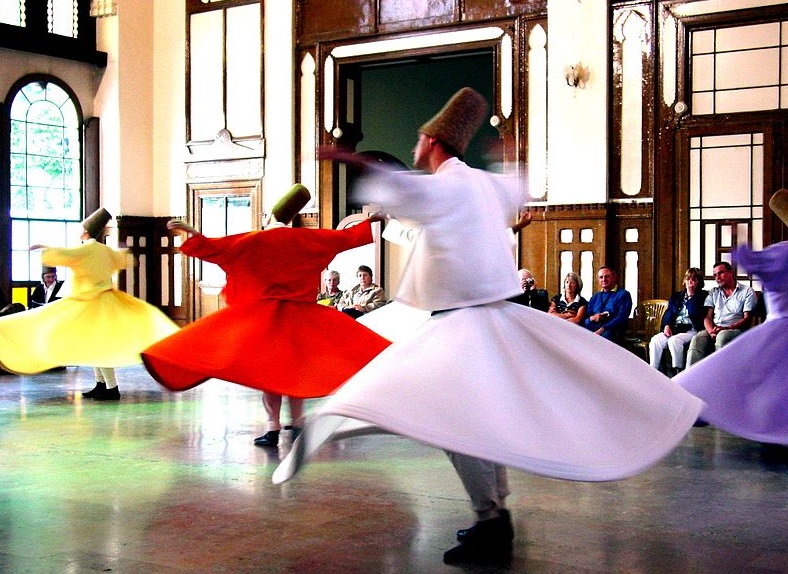
Image Attribution CC-SA 2.0 Vladimer Shioshivili June 10 2006 The earliest dances were likely tied to religion, using movement as part of rituals. Belief systems embraced dance as a way to connect to higher powers that influenced everyday life. Other religions eschewed dance or banned it for several different reasons. “Religious” can refer to a range of ecclesiastic-ism. Primitive imitative dances and dances to the elements like the sun and rain appealed to nature and the spirits whose benevolence made existence possible. Some dances are indigenous, but others have traveled, morphed, and adapted from earlier roots. By studying religious dance, you gain insight into the worship of different cultures.
All over the world, people dance. Different social dances have different purposes and different values. Sometimes they blend and merge with others to become new dances. But no matter what, we find a connection to others in social dance.
The term folk dance refers to the secular, recreational, and celebratory dance expression of a past or present culture. The term was coined in the 19th century by European scholars studying the culture and art forms of different world regions. These academics viewed the simple, untrained “folk” carrying on their ancestors’ ancient traditions and often wrote condescending descriptions of these activities. The term folk dance was accepted until the mid-20th century, when it was replaced with the more respectful term traditional dance. It can refer to dances of the people and often has a nationalistic purpose. Although they were original dances done by and for the people in their own communities, they are sometimes adapted for performances and performed by trained dancers. It should be noted that not all traditional dancers dropped the designation folk dance; some use the term as a source of pride.
Upon completion of this module, you will be able to:- Demonstrate a culturally informed dance aesthetic.
- Recognize the elements of dance and apply that knowledge to analyze, create and perform dance.
- Describe religious and social dances and illustrate how the dances fit into their world culture.
To achieve these objectives:- Read the Module 6 Introduction
- Read and view the materials in Ch. 6 So You Think You Know Dance
- Complete the assignments.
Module Pressbooks Resources and Activities
You will find the following resources and activities in this module at the Pressbooks website. Click on the links below to access or complete each item.
-
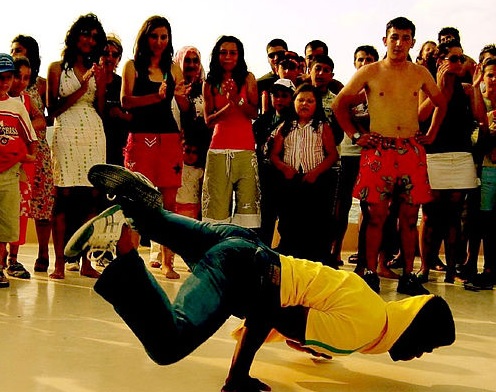
Image Attribution "B-boy breakdancing," CC-BY-SA 2.0 by E. Başak June 11 2006, Wikimedia Commons
This module includes two topics: Hip-Hop and Current Trends in Dance.
Hip-Hop is an umbrella term that includes several dance styles that are highly energetic and athletic. Hip-hop dance forms began as social dances that expanded to respond to socioeconomic conditions faced by marginalized African-American and Latinx youth in inner cities. These dance styles hold the meaning and values of the community, resulting in a cultural movement that gained widespread attention through media, leading to its global popularity today.
Dance in the 21st century is rapidly changing and continues to adapt in response to new circumstances in our social, political, and economic situations. Advances in technology are pushing the boundaries of dance in the dance field, dance as competition has become a lucrative business attracting dancers of all backgrounds, the health industry has embraced dance to promote individual’s overall well-being, and national and global dance initiatives have connected people to the broader community, and dance professionals seek to advance diversity, equity, and inclusion (DEI) in the dance field.
Upon completion of this module, you will be able to:
- Demonstrate a culturally informed dance aesthetic.
- Examine the origins of Hip-Hip
- Analyze the Hip-Hop cultural elements with pop culture
- Identify influential Hip-Hop artists
- Discuss current trends in dance
- Analyze cultural elements in current dance trends
- Identify influential multimedia artists
To achieve these objectives:
- Read the Module 7 Introduction.
- Read and view the materials in Ch. 7 and Ch. 8 So You Think You Know Dance.
- Complete the assignments.
Module Pressbooks Resources and Activities
You will find the following resources and activities in this module at the Pressbooks website. Click on the links below to access or complete each item.
- Demonstrate a culturally informed dance aesthetic.
-

Image Attribution CC-BY-NC-SA 2.0 Pedro Szekely May 11 2003
In this module you will take your final exam for this course. Read the instructions carefully and take note of any special submission guidelines.
Upon completion of this module, you will have:
- Read and viewed the final assessment instructions.
- Scheduled your exam with the proctoring service.
- Prepared and submitted your final assessment.
To achieve these objectives:
- Read and view the contents of the module book "Exam Information and Instructions"
- Log in to the proctoring service and take your exam.
